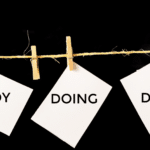[et_pb_section bb_built=”1″ _builder_version=”3.0.47″][et_pb_row _builder_version=”3.0.48″ background_size=”initial” background_position=”top_left” background_repeat=”repeat”][et_pb_column type=”4_4″][et_pb_text _builder_version=”3.17.6″ background_size=”initial” background_position=”top_left” background_repeat=”repeat”]
X
Do you ever feel as if you have too many balls in the air?
We all have our limits. Ever watch champion jugglers? As their audience applauds, they add object after object to their juggling mix. The crowd watches in awe and anticipation, knowing that if the jugglers add one too many, everything will come crashing down.
Life can be like that, too. When we have one too many projects in the air, our stress peaks, our thinking fuzzes, and we start dropping the balls. Often, we didn’t ask for these intruders to our schedules. We had a reasonable to-do list, but then the phone rang, and we had to add two more urgent items to our must-do list.
Maybe we don’t spill all our balls, but instead of feeling in balance, we’re now stressed, overwhelmed and disappointed in ourselves.
Not a good reward for our efforts.
How can we stop being pushed by our to-do lists and use our planning to pull us towards what we want to do?
Enter Personal Kanban
Last year a book came out, Personal Kanban by Jim Benson and Tonianne DeMaria Barry, that suggested a new approach to personal time management based on the principles of Kanban, used in the highly productive Japanese system of “Lean Manufacturing.”
Personal Kanban invites you to take information out of your head, write it down, and make it visual. It also encourages you to limit the items you are working on at any one time.
The process is helpful for those of us who: 1) carry a large amount of information in our heads (I used to, but that was forty years ago), and 2) try to work on lots of items from our to-do list at any one time and then complete very few.
Personal Kanban is about flow and releasing you from the rule of the to-do list. It’s ridiculously easy to try.
You write onto post-its all the work, projects, activities, and ideas for projects that you have on your plate. Then you stick the post-its on a whiteboard, placing them in an area you label OPTIONS or BACKLOG. (Name the columns as you like.) You then choose items to slide into a column marked READY from which you’ll choose three items for your DOING column. When work is complete, you slide it into DONE.
Then, voila, you monitor your flow of work and reflect on the results.

The key is to limit your work in progress–the “doings.” Rather than doing a little bit of a lot of things at any one time, you focus on the few things you most want to get done. If you are working on a big project, you slice off the piece you can do today–the one call you need to make.
You focus more, stress less, and typically get more done. But Personal Kanban is not just about getting a lot of stuff done–it’s also about making choices that can, in the words of Marie Kondo, bring you joy.
Resist the tyranny of to-do’s
Focusing on to-do lists can fry your brain because to-do lists are static, and almost always getting longer. What was “important” today, to use Stephen Covey’s categorization of high-value activities, may not be important tomorrow.
With Personal Kanban you can revise the flow based on new information or shifts in your life. For example, I may be writing a chapter of my book (important), when I remember my Granddaughter’s birthday. I slip it onto my DOING list, perhaps bumping something else because I know that sending her a gift is key to my satisfaction for the day.
Kanban maps are fluid and visual. They can also be colorful–which for me is a big plus. Seeing the rows of columns allows me to focus on the few things I can do, not the whole list of options for what I might do.
Instead of being “pushed” by my to-do list I’m “pulled” by what I choose to do.
It’s super easy to start
With barely more information than what is in this post, you can set up your system, although I highly recommend the book . or some of the explanatory videos you can find online.
Step one:
You start by doing an enormous brain dump and visualizing ALL of the work and activities clamoring for your attention. Take out a stack of post-its and write down everything you have open, or might have open in the way of a project, commitment, one idea to a note.
The trip you are planning. The birthday gift you need to buy. The client you need to call back.
You will stick all your post-its or stack your cards in an area (column or list” in Trello) called OPTIONS. (In the original system it was called BACKLOG.)
Step Two
Create a column called READY. The work that you select represents what you will choose from today. You can also call it TODAY. Every day you will spend a few moments reflecting on what is essential today and arranging your lists. You want to be able to finish what you start, so you may want to break apart big projects into bite-size steps. Even a project as small as putting out a blog post can have discrete steps like “write,” “edit,” and “publish.”
Step three
Here’s the critical part. Select up to three post-its or cards for your DOING column, your work in progress This will focus your attention on what you want to finish today. Once you complete a task, you move it into the DONE column. After you’ve completed your three work-in-progress items, you can choose something new, or take a break and celebrate.
Step four
Once a work-in-progress is complete move the card or post-it to your column called DONE.
If you need to wait for a response from someone, create a column called WAITING, or The PEN or ON-HOLD and put the card in this waiting bin.
Voila, Now you have a visual map that allows you to watch your work, activities, and processes move from ready to complete.
Step five
Take time to reflect on what you learn. You can even add a column called reflections. And celebrate!
It’s flexible
I do my Kanban map on the computer, using a piece of online software called Trello that feels like a mobile whiteboard. With Trello, you create cards and “pin” them on an electronic whiteboard. Even though I love the idea of standing in front of a large whiteboard sticking on lots of colorful post-its, the portability of an online program works better for me.
With one week into the process of using Personal Kanban, I’m already achieving results with less stress. I’m less tempted to go on a task marathon and start checking items off my list just because I can. With Personal Kanban, I make choices. I may decide to slide some small tasks into DOING, but I do this intntionally based on my view of the whole. And most importantly, I limit what I’m focused on at any one time.
The authors write,
We need to define our work, rather than let our work define us. To escape the tyranny of push [by our to-do lists or obligations], we must complete what we start, exercise options for effectiveness, and increase the occurrence of what brings us joy.
Yep. Who wants just to do tasks when we can choose more joy?
[/et_pb_text][/et_pb_column][/et_pb_row][/et_pb_section]










2 Responses